Abstract
The development of advanced high-strength steel has become the research focus of steel in order to meet low emission requirements. Different annealing temperatures from 600 °C to 900 °C were applied to 1200 MPa Grade 13Mn TRIP steels with (30B steel) or without B (0B steel). The effects of B addition on microstructure and mechanical properties with different annealing temperatures were investigated. Except for M2B in 30B steel, both steels annealed at 600 °C or 700 °C contained only austenite. When annealed at 800 °C or 900 °C, ε-martensite and α′-martensite were observed whereas 30B steel had less of them. 30B steel had higher yield strength (YS) and tensile strength (TS) regardless of the annealing temperature. Total elongation (TE) of 30B steel was smaller when annealed at 600 °C or 700 °C but larger at 800 °C or 900 °C. B addition refined austenite grains, and therefore depressed phase transformation to ε-martensite and α′-martensite during annealing. B addition enhanced YS and TS by refining grains, hindering dislocation movement and promoting phase transformation, but changed the fracture mechanism. The best TS × TE (53.62 GPa%) for 30B steel was reached when annealed at 800 °C. The more sufficiently triggered TRIP effect in high-temperature-annealed 30B steel accounts for its scarcely decreased TS and high TE.
1. Introduction
As increasing attention has been paid to environmental protection and energy-saving, third-generation advanced high-strength steel (AHSS) has become the research focus of steel materials worldwide. Utilizing the transformation-induced-plasticity (TRIP) effect is one of the most effective ways for developing third-generation AHSS as the transformation from austenite(γ) to martensite in steel during straining could give rise to both strength and plasticity of the steel [1,2,3,4,5,6].
Quench and partitioning (Q&P) steel is considered a part of third-generation AHSS. With the partitioning of carbon, Q&P steel can obtain the structure of α′-martensite (α′) and γ. The relatively hard α′ matrix and the transformation from γ to α′ make the steel able to reach ultimate tensile strengths in excess of 1500 to 1700 MPa and elongations to failure of 20% to 10% [7,8,9,10,11]. Medium Mn steel, with Mn contents in the range of 5–10 wt.%, is also considered as a promising candidate for third-generation AHSS. Ultra-fine-grained (UFG) microstructure can be obtained by the intercritical annealing process. Due to a combination of grain size refinement and partitioning effects, a large volume fraction of UFG γ can be stabilized at room temperature. This results in a superior combination of an ultra-high ultimate tensile strength and an exceptionally large uniform elongation due to the occurrence of martensitic transformation [12,13,14,15,16].
High-Mn TRIP steel, which is mainly composed of metastable γ that can transform to martensite in the process of deformation, is another potential member of the third generation of AHSS. Research [17,18,19] shows that when stacking fault energy (SFE) is in the range of 12 to 18 mJ/m2, both mechanical twins and martensite transformation can occur, and for steels with SFE ≤ 12 mJ/m2, γ will transform to martensite without twin formation. Particularly, two-stage γ → ε-martensite (ε)→ α′ phase transformation can be commonly observed during deformation when the carbon content is below 0.2 wt.% [20,21,22,23]. During the two-stage transformation, γ first transforms to ε and segments the original γ grains into thinner bands. In addition, the size of the later-formed α′ is smaller as the growth is hindered by the thin γ and ε bands. The two-stage phase transformation and transformation-induced microstructure refinement lead to the steels’ high tensile strength (TS) exceeding 1200 MPa and total elongation (TE) of more than 30% [22,23].
Normally, B is added at no more than 0.003% in steels such as 22 MnB5 to improve hardenability [24,25]. Excessive boron addition would do harm to ductility due to the formation of boride nets in the grain boundary [26,27,28]. However, some works [29,30,31] claim that with acceptable detriment to ductility, the addition of B can increase the strength of austenitic steels. In our previous work [32,33], high-Mn TRIP steels with mechanical properties within the third AHSS window were manufactured with boron introduced to the alloy system. In the as-hot-rolled steel, it was witnessed that 0.30 wt.% B addition improves the yield strength (YS) with a slight detriment to TE. In this work, different annealing temperatures from 600 °C to 900 °C were applied to the steel as well as reference steel with the same chemical composition except for the addition of B. The effect of B addition on the microstructure and mechanical properties of the steels with different annealing temperatures was investigated. Steels with TS of more than 1200 MPa and TE higher than 40% were obtained. The work offers clues for approaches to developing new structural third-generation AHSSs with superior mechanical properties.
2. Materials and Methods
Ingots with the chemical compositions listed in Table 1 were made using a vacuum induction furnace. The ingots were then forged to a thickness of 40 mm at 1050 °C. After homogenizing at 1050 °C for 60 min, the ingots were hot-rolled at 1050 °C to 2 mm thick with heat preservation at 1050°C for 3 min between each pass, followed by being water-cooled to room temperature. The total hot rolling reduction was 95%. The hot-rolled plants were subjected to isothermal heat treatments at 600, 700, 800, 900 °C for 10 min and cooled in water. The steels were named 0B/30B steel, respectively, according to their boron content. The hot-rolled samples were named 0B/30B-HR, and corresponding annealed samples were named 0B/30B-600/700/800/900, respectively, due to the isothermal annealing temperature.

Table 1.
Chemical compositions of the experimental steels (in wt.%). The C content was analyzed by using a carbon-sulfur analyzer (CS-2800) with an error of 3%. The Mn content was determined by titration with an error of 1%. The B content was analyzed by spectrophotometry using a 722SP spectrophotometer with an error of 5%. The content of Cr, Ni, Si and Cu was analyzed by using an inductively coupled plasma optical emission spectrometer (VARIAN ICP-OES 715-ES) with 2% error.
Tensile specimens of 6 mm in width and a gauge length of 25 mm were machined from the annealed samples with the tensile axis parallel to the rolling direction. The thickness of the tensile samples was consistent with the hot-rolled state except for necessary polishing to remove the oxide layer. Tensile tests were carried out at room temperature using a universal testing machine (MTSE45.305) at a constant crosshead speed of 1 mm/min. Tensile tests were performed three times and the average values were taken.
Specimens were electrolytically polished in a mixture reagent of 10 vol.% perchloric acid and 90 vol.% ethanol with a voltage of 12 V for 20–25 s before electron backscatter diffraction (EBSD, HSHR (TKD)) and X-ray diffraction (XRD, Bruker D8 Advance) characterization. The EBSD experiments were carried out with a voltage of 20 kV and a step size of 0.25 μm. The EBSD data were analyzed using the HKL Channel 5 software package distributed by Oxford Instruments. XRD experiments were operated at 40 kV with a current of 40 mA and a step size of 0.02°. All samples were scanned in a range from 30° to 100° 2θ at 2°/min using a Cu-Kα radiation source. The phase fraction from XRD was quantified by Rietveld refinement [34,35,36,37] using DIFFRAC TOPAS 4.2 software. The background was refined by fourth-order Chebyshev function, and the peak shift was estimated by refining the zero error. The reference Powder Diffraction File card numbers for γ, ε and α′ were 23-0298, 34-0529 and 65-4899, respectively, and the specific lattice parameters were refined during the Rietveld refinement. In addition, the preferred orientation of the phases was refined utilizing the spherical harmonic with up to eight orders. The refinement of the strain was also conducted to include the influence of residual stress on the fitting. The weighted-profile R (Rwp) value and the goodness-of-fit (χ2) were employed to estimate the quality of the fittings. Rwp ≤ 15% and 1 < χ2 < 2 were reached during the applied refinements. In order to get better results, M2B was neglected in the refinements. The fracture surfaces of the tensile samples were observed by scanning electron microscopy (SEM, ZEISS, ULTRA 55).
3. Results
3.1. Microstructure of the Experimental Steel after Annealing
Figure 1 shows microstructures of 0B steel in a hot-rolled state and annealed at different temperatures. Annealed twinning can be observed in all samples. The microstructure of 0B-HR was elongated γ along the rolling direction. In 0B-600 and 0B-700, the elongated γ remained, but in 0B-800 and 0B-900, with the activation of γ recrystallization, the banded structure was reduced. Meanwhile, ε and α′ were observed in 0B-800 and 0B-900. As for 30B steel (Figure 2), the phase evolution trend was similar. However, more γ was retained in 30B-800 and 30B-900 compared with 0B samples with the same annealing temperatures. Meanwhile, the addition of B introduced an M2B phase in the 30B steel. As shown in Figure 2a, dispersed distributed rod-like M2B initially existed in 30B-HR. The M2B was mainly found near the grain boundaries of γ. During the annealing process, the M2B remained undissolved as similar M2B was also observed in the annealed 30B samples. Table 2 summarizes the phase fraction according to the EBSD results. Since the phase fraction from EBSD could be unreliable due to limited characterized areas, XRD experiments were also carried out to obtain more accurate phase fractions. XRD patterns (Figure 3) exhibited the same phase constitutions as the EBSD, and the calculated phase fraction results for samples annealed at higher than 800 °C are shown in Table 3. Although some differences were witnessed between EBSD and XRD results, the general trends of phase fraction changes were the same. In addition, the average γ grain size (original γ grain size before transformed to ε or α′ when annealed at 800 °C or 900 °C, AGS) of the samples was calculated by counting the number of γ grains in the EBSD mapping. Grains not completely included in the images were counted as 0.5 grains. For 600 °C and 700 °C annealed samples without ε and α′, the numbers of γ grains were directly obtained from the “grain detection” module. Grains with fewer than 10–15 pixels were neglected according to data quality. For 800 °C and 900 °C annealed samples where the “grain detection” module was not suitable because the original γ grain could be divided by ε and α′, the amounts were counted manually. The calculated AGSs are also summarized in Table 2. On the one hand, the AGSs of the 30B samples were much smaller. On the other hand, the AGS changes of 0B steel and 30B steel with annealing temperature were the same. Annealing at 600 °C or 700 °C did not change the AGS significantly, but when annealed at higher temperatures, the AGS increased with increasing annealing temperature. For 0B steel, the AGS grew from around 10 μm to 17.82 μm in 0B-800 and 24.50 μm in 0B-900, whereas for 30B steel, the AGS rose from approximately 5 μm to 10.37 μm in 30B-800 and 17.95 μm in 30B-900.
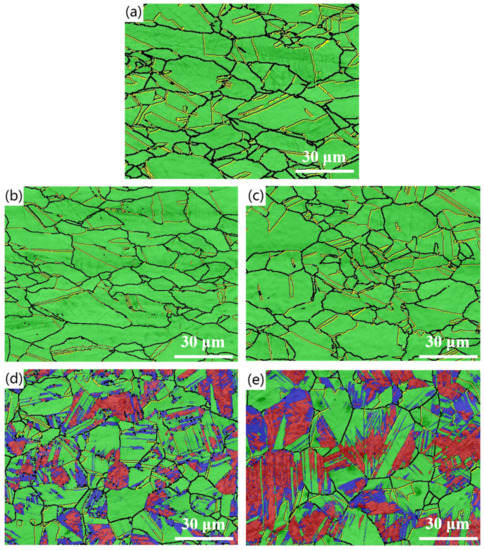
Figure 1.
EBSD phase maps on band contrast of 0B steel with different annealing temperatures. (a) 0B-HR; (b) 0B-600; (c) 0B-700; (d) 0B-800; (e) 0B-900. Green = γ, blue = ε, red = α′, black = unindexed areas/grain boundaries, yellow = twinning boundaries. Rolling direction = horizontal, thickness direction = vertical.
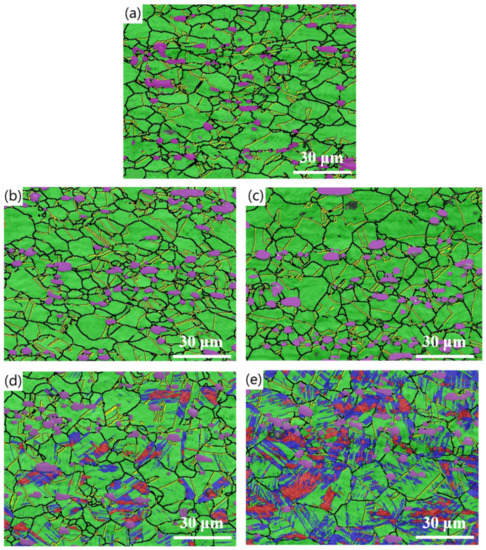
Figure 2.
EBSD phase maps on band contrast of 30B steel with different annealing temperatures. (a) 30B-HR; (b) 30B-600; (c) 30B-700; (d) 30B-800; (e) 30B-900. Green = γ, blue = ε, red = α′, violet = M2B, black = unindexed areas/grain boundaries, yellow = twinning boundaries. Rolling direction = horizontal, thickness direction = vertical.

Table 2.
Phase fractions and AGS of the annealed samples according to EBSD.
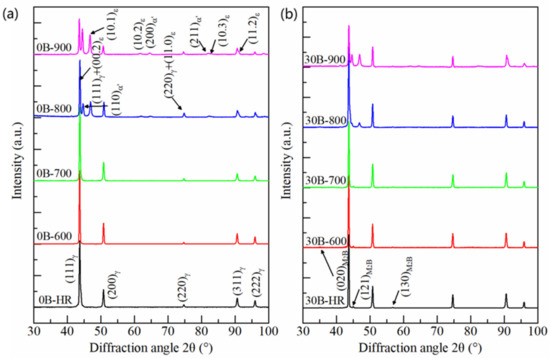
Figure 3.
XRD patterns of the hot-rolled and annealed samples. (a) 0B steel; (b) 30B steel.

Table 3.
Phase fractions of annealed samples with multiple phases according to XRD.
3.2. Mechanical Properties
Figure 4 shows the engineering stress-strain curves of the experimental steels, and corresponding mechanical properties are shown in Table 4. A series of mechanical properties of around 1200 MPa with continuous yielding were obtained. 30B steel exhibited TS always higher than 1200 MPa with varied YS and TE, whereas only 0B-700 reached TS of 1200 MPa for 0B steel. Serrations were observed on the curves due to dynamic strain aging [38] and discontinuous phase transformation [39]. In general, 30B steel had higher YS and TS than 0B steel. When annealed at 600 °C or 700 °C, the YS of both 0B steel and 30B steel kept steady whereas the TE of 30B steel was lower than that of 0B steel. Compared with 600 °C annealed samples, the TE and TS of the 700 °C annealed samples were slightly higher. With annealing temperatures higher than 800 °C, the YS of both steels kept decreasing but different variation trends in the TE and TS were observed. For 0B steel, the TS and TE started to decrease significantly from 800 °C. However, for 30B steel, TS only decreased slightly and still remained higher than 1200 MPa even when annealed at 900 °C. Meanwhile, the TE of 30B-800 and 30B-900 did not drop but rose to around 43%.
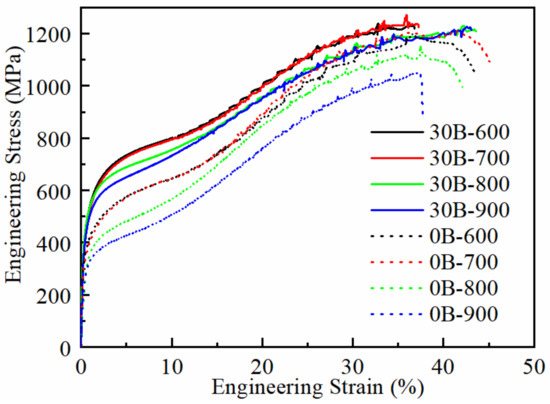
Figure 4.
Engineering stress-strain curves of the annealed samples.

Table 4.
Mechanical properties of the annealed samples.
4. Discussion
4.1. Influence of Annealing Temperature on the Microstructure Evolution
As the influences of annealing temperature on 0B steel and 30B steel were similar, they are here discussed simultaneously. When annealed at 600 °C and 700 °C, the main change during annealing was the recovery of dislocations. Figure 5 segmented γ into recrystallized (in blue) and non-recrystallized (in yellow) fractions after annealing at 700 °C. A few recrystallized grains were observed, but due to the relatively low temperature, the growth of the γ grains was limited. When the annealing temperature was raised to 800 °C, significant recrystallization of γ happened and the growth of recrystallized grains became common. The formation of ε and α′ is due to the low stacking fault energy (SFE) of the materials. Using Olson and Cohen’s equation [40] and the model raised by Dumay [41], the SFE of 0B steel was calculated as 0.2 mJ/m2. For 30B steel, as B can scarcely form a solute in the matrix, its influence on the SFE in this model was neglected. Due to the unavoidable element segregation, especially Mn segregation, the SFE may vary from region to region in the material. In other words, SFE in some areas of the samples may be even lower than 0. Hence, once cooled from a high temperature, ε could be formed in recrystallized γ and α′ was formed later inside the ε bands. Except for the effect of the solute element, grain size also affects the SFE [42,43,44,45]. The excess of free energy ΔGex produced by grain size d (μm) is commonly expressed by the equation given below [43],
ΔGex = 170.06exp(−d/18.55)
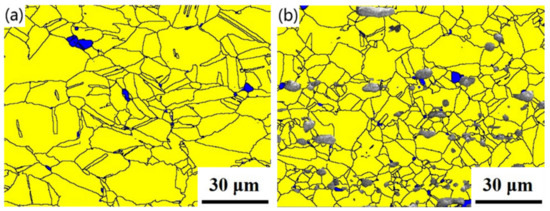
Figure 5.
γ grains segmented into recrystallized (in blue) and non-recrystallized (in yellow) fractions after annealing at 700 °C. (a) 0B-700; (b) 30B-700. Grain boundaries are shown in black. Areas of M2B in (b) are shown by band contrast. Rolling direction = horizontal, thickness direction = vertical.
The calculated changes of 0B steel’s SFE with grain size are shown in Figure 6. SFE decreases with increasing grain size. Thereby, compared with the 800 °C annealed samples, the 900 °C annealed samples, which had larger original γ grains, had lower SFE. The low SFE led to its lower γ stability and the formation of the higher fraction of ε and α′. For 600 °C and 700 °C annealed samples, the formation of ε or α′ was suppressed not only by the grain size effect, but also by their high dislocation density. The formation of ɛ-martensite is the result of extended stacking faults in every two parallel dense planes {111}. The massy inactivated dislocations inherited from hot rolling in the lower-temperature-annealed samples hindered the extent of stacking faults and thereby obstructed the formation of ε and α′.
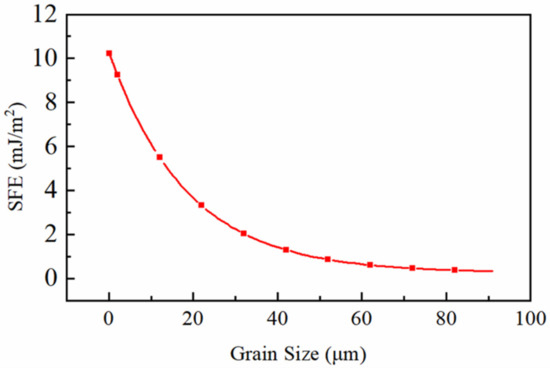
Figure 6.
Influence of grain size on SFE of 0B steel.
4.2. Influence of B Addition on Microstructure Evolution
The introduction of B first brought the M2B phase to the microstructure. Figure 7 shows the formation process of M2B in 30B steel calculated by Thermal Calc 2021A. The M2B phase was formed by a eutectic reaction during solidification. As a poorly soluble element in steel, most of the B in the alloy system was consumed by forming M2B. In the annealed samples, the precipitated M2B distributes dispersedly on the matrix, as observed in Figure 2. During the annealing process, the fraction of M2B remains at around 6% (Table 2), proving that the M2B phase remained undissolved during the annealing process. The dispersed distributed M2B acted as an obstacle to the growth of grains during hot rolling. Therefore, 30B-600 and 30B-700, which had similar grain boundaries with the hot-rolled state, have smaller AGS (less than 6 μm) compared with 0B-600 and 0B-700 (around 10 μm). Apart from the smaller grain size before annealing, when recrystallization was activated during the annealing process, the M2B once again hindered the growth of recrystallized grains. Hence, when annealed at 800 °C or 900 °C, the AGS of 30B steel remained smaller than the AGS of 0B steel.
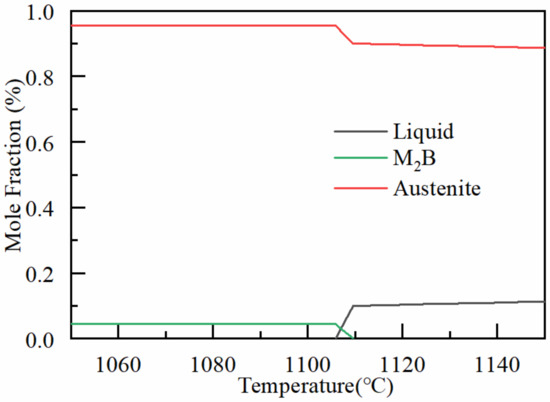
Figure 7.
Calculated phase map of 30B steel by Thermal Calc 2021A.
As we mentioned above, SFE is influenced by grain size. Therefore, although B can hardly be dissolved in the alloy system, it increased the SFE by influencing the γ grain size. The finer γ grains and increased SFE stabilized the original γ during the 800 °C/900 °C annealing of 30B steel and therefore, more γ was retained in 30B steel after annealing compared with 0B steel.
4.3. Enhanced Mechanical Properties by the Introduction of M2B
The strengthening by B addition is attributed to the following factors. Firstly, as the AGS of 30B steel was much smaller than that of 0B steel with the same annealing temperature, the grain refinement effect played an essential role in strengthening 30B steel. Calculated by the Hall–Patch relation [46,47]:
where K is the Hall–Patch parameter for γ (= 9.49 MPa·mm1/2 [48]), and d is the average grain size, the contribution of the grain boundary strengthening was 93 MPa for 0B-600 and that of 30B-600 was 131 MPa. The difference was only 38 MPa, which is much smaller than the difference between the YS of the steels. Therefore, the addition of B must exert influence in some other ways.
Demonstrated by our former research [32,33,39], γ → ε → α′ phase transformation happened during the deformation of the hot-rolled 0B/30B steel and the TRIP effect acted as the main strengthening mechanism. Figure 8 shows the SEM and EBSD phase maps of 30B-600 and 30B-900 after fracture. Although cracked M2B can be observed, deformation-induced α′ dominated the microstructures with a small amount of remaining γ and ε, indicating that the TRIP effect still took up a prominent role during deformation in our annealed steels investigated in this research. During early deformation, plastic yielding started first in γ while the hard M2B phases remained in the elastic state. The dislocation movement was unavoidably hindered by the interface of γ-M2B and this contributed to the higher YS of 30B steel. Thereafter, with further deformation, high local stress was accumulated besides M2B. The stress concentration promoted phase transformation and led to the higher TS of 30B steel.
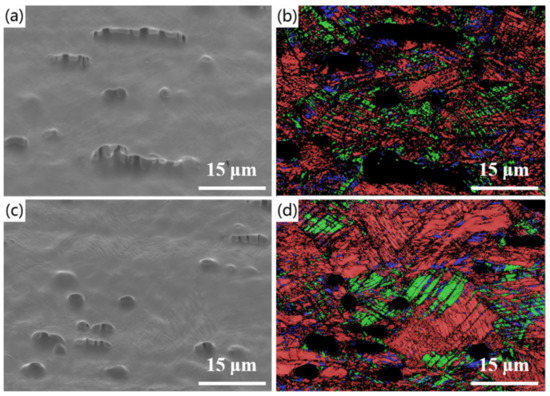
Figure 8.
SEM and EBSD phase maps of 30B-600 and 30B-900 after fracture. (a) SEM of 30B-600; (b) EBSD phase map of area in (a); (c) SEM of 30B-900; (d) EBSD phase map of area in (c). In the phase maps, green = γ, blue = ε, red = α′, black = unindexed areas/M2B. Rolling direction = horizontal, thickness direction = vertical.
Apart from strengthening, the early cracked M2B harmed the TE of the steel. Figure 9 shows the fracture surface of the samples. Whereas 0B steel exhibited typical ductile fracture with relatively uniform small dimples, the fracture surfaces of 30B steel showed mixed structures of deep voids and small dimples, and M2B can be observed in the voids. The fracture morphologies of 30B steel indicate that M2B changed the fracture mechanism. During the tension of 30B steel, M2B cracked early and voids were formed. Although the voids did not generate instant fracture due to the excellent crack resistance of TRIP steels, they grew larger during further deformation, finally reached the limit and led to the fracture. At that time, the matrixes between the voids were torn and small dimples were formed.
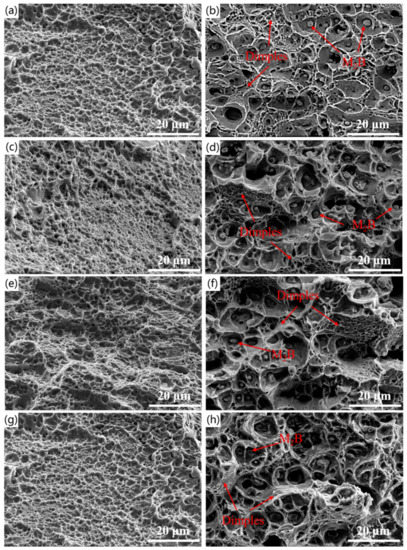
Figure 9.
Fracture morphologies of the samples. (a) 0B-600; (b) 30B-600; (c) 0B-700; (d) 30B-700; (e) 0B-800; (f) 30B-800; (g) 0B-900; (h) 30B-900.
Based on the above discussions, it is not surprising that 30B steel had higher YS and TS and lower TE than 0B steel when annealed at 600 °C and 700 °C. Additionally, when annealed at 700 °C, the small recrystallized grains in the microstructure compromised the loss of YS caused by the decline of dislocation density. Therefore, the YS of 700 °C annealed samples did not change much compared with 600 °C annealed samples. The refined recrystallized grains and their hindering of dislocation movement during further deformation promoted the activation of phase transformation, leading to the increased strain hardening rate, TS and TE in 700 °C annealed samples. The increments were smaller in 30B-700 because the effects were overwhelmed by the similar effects brought by M2B.
With higher annealing temperatures of 800 °C and 900 °C, the changes in YS, TS and TE of 0B steel were comprehensible as a result of increasing AGS, and the high fractions of ε and α′ as well as γ-ε and γ-α′ interfaces in their initial microstructures, which accelerated the nucleation and coalescence of micro-cracks. For 30B steel, we witnessed a similar drop of YS but TS did not drop much, and the TEs of 30B-800 and 30B-900 were even higher than those of 30B-600 and 30B-700. This is related to the difference between γ stability in the samples annealed at different temperatures and the fracture caused by M2B. Figure 10 shows the XRD patterns of the fractured 30B samples, and the calculated phase fractions are summarized in Table 5. 30B-600 and 30B-700 contained higher fractions of γ after fracture, indicating that the fracture caused by M2B limited martensitic transformation in 30B-600 and 30B-700. The TRIP effect was not activated in some γ grains with higher stability. When the annealing temperature was increased, the stability of γ in 30B steel was decreased considering the size effect. Meanwhile, the growth of recrystallized γ grains was retarded by M2B and more γ was retained. Thus, more γ → ε and ε → α′ phase transformations were induced in 30B-800 and 30B-900 during deformation. The more sufficiently utilized TRIP effect, therefore, led to higher TE and compromised some of the loss of TS caused by increasing AGS.
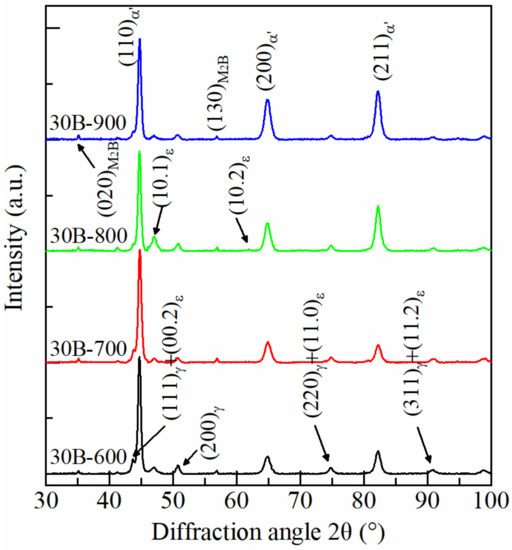
Figure 10.
XRD patterns of the fractured 30B samples.

Table 5.
Calculated phase fraction (%) in 30B steel samples after tensile test according to XRD.
5. Conclusions
In this work, different annealing temperatures from 600 °C to 900 °C were applied to 0B and 30B high-Mn TRIP steels. A series of mechanical properties with TS of more than 1200 MPa and high TE were obtained. The effect of B addition on microstructure and mechanical properties of the steels was analyzed. The main results and conclusions derived from our research are summarized below.
- Except for the appearance of M2B in 30B steel, similar phase constitutions were observed in 0B steel and 30B steel with the same annealing temperature. When the annealing was lower than 700 °C, the microstructure contained elongated γ along the rolling direction. When annealed at 800 °C or 900 °C, ε and α′ were formed due to recrystallization of γ. The fraction of ε + α′ increased in 0B-900 and 30B-900 due to their larger AGSs.
- With the addition of B, dispersed distributed M2B was formed in 30B steel, which resulted in the refinement of γ grains during both the hot-rolling and annealing processes. As SFE is influenced by grain size, the addition of B can give rise to SFE. Hence, less ε + α′ was formed in 30B steel compared with 0B steel when annealed at 800 °C or 900 °C.
- The addition of B increased the YS and the TS of 30B steel. The improvements are brought by the grain refinement, as well as the hindering of dislocation movement and promoted phase transformation due to M2B dispersion. Meanwhile, M2B cracked early during deformation, converted the fracture mechanism and caused the loss of TE.
- B addition significantly restrained the decline of TS and TE when annealed at high temperatures. Whereas the TS and TE of 0B steel decreased significantly with annealing temperatures higher than 800 °C, the more sufficiently triggered TRIP effect in 30B steel compromised the loss of TS and increased the TE. Consequently, the TS of 30B steel was maintained at higher than 1200 MPa and reached the best TS × TE of 53.62 GPa% when annealed at 800 °C.
Author Contributions
Conceptualization, F.L. and Z.Z.; methodology, F.L. and Z.Z.; validation, J.L. and Y.Z.; formal analysis, F.L., P.G. and J.L.; investigation, F.L. and T.K.; writing—original draft preparation, F.L.; writing—review and editing, all authors; visualization, F.L. and P.G.; supervision, Z.Z.; project administration, Z.Z.; funding acquisition, Z.Z. All authors have read and agreed to the published version of the manuscript.
Funding
This research was funded by the New Energy Automobile Material Production and Application Demonstration Platform Project, grant number TC180A6MR-1 and the Key Research and Development Plan of Shandong Province, grant number 2019TSLH0103.
Data Availability Statement
Not applicable.
Conflicts of Interest
The authors declare no conflict of interest.
References
- Herrera, C.; Ponge, D.; Raabe, D. Design of a novel Mn-based 1 GPa duplex stainless TRIP steel with 60% ductility by a reduction of austenite stability. Acta Mater. 2011, 59, 4653–4664. [Google Scholar] [CrossRef]
- Harjo, S.; Tsuchida, N.; Abe, J.; Gong, W. Martensite phase stress and the strengthening mechanism in TRIP steel by neutron diffraction. Sci. Rep. 2017, 7, 15149. [Google Scholar] [CrossRef]
- Zhao, J.l.; Xi, Y.; Shi, W.; Li, L. Microstructure and Mechanical Properties of High Manganese TRIP Steel. J. Iron Steel Res. Int. 2012, 19, 57–62. [Google Scholar] [CrossRef]
- Gao, P.; Chen, W.; Li, F.; Ning, B.; Zhao, Z. New crystallography insights of retained austenite transformation in an intercritical annealed quenching and partitioning steel. Mater. Lett. 2020, 273, 127955. [Google Scholar] [CrossRef]
- Nanda, T.; Singh, V.; Singh, V.; Chakraborty, A.; Sharma, S. Third generation of advanced high-strength steels: Processing routes and properties. Proc. Inst. Mech. Eng. Part L J. Mater. Des. Appl. 2019, 233, 209–238. [Google Scholar] [CrossRef]
- Zhao, J.; Jiang, Z. Thermomechanical processing of advanced high strength steels. Prog. Mater. Sci. 2018, 94, 174–242. [Google Scholar] [CrossRef]
- Cho, L.; Seo, E.J.; de Cooman, B.C. Near-Ac3 austenitized ultra-fine-grained quenching and partitioning (Q&P) steel. Scr. Mater. 2016, 123, 69–72. [Google Scholar] [CrossRef]
- Seo, E.J.; Cho, L.; Estrin, Y.; de Cooman, B.C. Microstructure-mechanical properties relationships for quenching and partitioning (Q&P) processed steel. Acta Mater. 2016, 113, 124–139. [Google Scholar] [CrossRef]
- Li, Q.; Huang, X.; Huang, W. EBSD Analysis of Relationship Between Microstructural Features and Toughness of a Medium-Carbon Quenching and Partitioning Bainitic Steel. J. Mater. Eng. Perform. 2017, 26, 6149–6157. [Google Scholar] [CrossRef]
- Gao, P.; Chen, W.; Li, F.; Ning, B.; Zhao, Z. Quasi-Situ Characterization of Deformation in Low-Carbon Steel with Equiaxed and Lamellar Microstructure Treated by the Quenching and Partitioning Process. Acta Met. Sin. Engl. Lett. 2020, 33, 1657–1665. [Google Scholar] [CrossRef]
- Wang, L.; Speer, J.G. Quenching and Partitioning Steel Heat Treatment. Met. Microstruct. Anal. 2013, 2, 268–281. [Google Scholar] [CrossRef]
- Ding, R.; Dai, Z.; Huang, M.; Yang, Z.; Zhang, C.; Chen, H. Effect of pre-existed austenite on austenite reversion and mechanical behavior of an Fe-0.2C-8Mn-2Al medium Mn steel. Acta Mater. 2018, 147, 59–69. [Google Scholar] [CrossRef]
- Shi, J.; Sun, X.; Wang, M.; Hui, W.; Dong, H.; Cao, W. Enhanced work-hardening behavior and mechanical properties in ultrafine-grained steels with large-fractioned metastable austenite. Scr. Mater. 2010, 63, 815–818. [Google Scholar] [CrossRef]
- Xu, H.F.; Zhao, J.; Cao, W.Q.; Shi, J.; Wang, C.Y.; Wang, C.; Li, J.; Dong, H. Heat treatment effects on the microstructure and mechanical properties of a medium manganese steel (0.2C–5Mn). Mater. Sci. Eng. A 2012, 532, 435–442. [Google Scholar] [CrossRef]
- Cao, W.Q.; Wang, C.; Shi, J.; Wang, M.Q.; Hui, W.J.; Dong, H. Microstructure and mechanical properties of Fe-0.2C-5Mn steel processed by ART-annealing. Mater. Sci. Eng. A 2011, 528, 6661–6666. [Google Scholar] [CrossRef]
- Hu, B.; He, B.b.; Cheng, G.J.; Yen, H.W.; Huang, M.X.; Luo, H.W. Super-high-strength and formable medium Mn steel manufactured by warm rolling process. Acta Mater. 2019, 174, 131–141. [Google Scholar] [CrossRef]
- Curtze, S.; Kuokkala, V.T. Dependence of tensile deformation behavior of TWIP steels on stacking fault energy, temperature and strain rate. Acta Mater. 2010, 58, 5129–5141. [Google Scholar] [CrossRef]
- De Cooman, B.C.; Estrin, Y.; Kim, S.K. Twinning-induced plasticity (TWIP) steels. Acta Mater. 2018, 142, 283–362. [Google Scholar] [CrossRef]
- Allain, S.; Chateau, J.P.; Bouaziz, O.; Migot, S.; Guelton, N. Correlations between the calculated stacking fault energy and the plasticity mechanisms in Fe-Mn-C alloys. Mater. Sci. Eng. A 2004, 387–389, 158–162. [Google Scholar] [CrossRef]
- Yang, W.S.; Wan, C.M. The influence of aluminium content to the stacking fault energy in Fe-Mn-Al-C alloy system. J. Mater. Sci. 1990, 25, 1821–1823. [Google Scholar] [CrossRef]
- Suh, D.W.; Park, S.J.; Lee, C.H.; Kim, S.J. Microstructure and mechanical behaviors of 0.1C-13Mn metastable austenitic steel. Met. Mater. Trans. A 2009, 40, 264–268. [Google Scholar] [CrossRef][Green Version]
- McGrath, M.C.; van Aken, D.C.; Medvedeva, N.I.; Medvedeva, J.E. Work hardening behavior in steel with multiple TRIP mechanisms. Met. Mater. Trans. A 2013, 44, 4634–4643. [Google Scholar] [CrossRef]
- Field, D.M.; Qing, J.; van Aken, D.C. Chemistry and Properties of Medium-Mn Two-Stage TRIP Steels. Met. Mater. Trans. A 2018, 49, 4615–4632. [Google Scholar] [CrossRef]
- Naderi, M.; Durrenberger, L.; Molinari, A.; Bleck, W. Constitutive relationships for 22MnB5 boron steel deformed isothermally at high temperatures. Mater. Sci. Eng. A 2008, 478, 130–139. [Google Scholar] [CrossRef]
- Karbasian, H.; Tekkaya, A.E. A review on hot stamping. J. Mater. Process. Technol. 2010, 210, 2103–2118. [Google Scholar] [CrossRef]
- Jones, R.B.; Younes, C.M.; Heard, P.J.; Wild, R.K.; Flewitt, P.E.J. The effect of the microscale distribution of boron on the yield strength of C–Mn steels subjected to neutron irradiation. Acta Mater. 2002, 50, 4395–4417. [Google Scholar] [CrossRef]
- Jahazi, M.; Jonas, J.J. The non-equilibrium segregation of boron on original and moving austenite grain boundaries. Mater. Sci. Eng. A 2002, 335, 49–61. [Google Scholar] [CrossRef]
- Suzuki, S.; Abiko, K.; Kimura, H. Phosphorus segregation related to the grain boundary structure in an Fe-P alloy. Scr. Met. 1981, 15, 1139–1143. [Google Scholar] [CrossRef]
- Branagan, D.; Frerichs, A.; Meacham, B.; Ma, L.; Yakubtsov, I.; Cheng, S.; Sergueeva, A. New Mechanisms, Enabling Structures, and Advanced Properties Resulting in a New Class of 3rd Generation AHSS Sheet; SAE Technical Paper 2014-01-0989; SAE International: New York, NY, USA, 2014. [Google Scholar] [CrossRef]
- Askari-Paykani, M.; Shahverdi, H.R.; Miresmaeili, R. Effect of Boron Addition on Microstructural Evolution and Room-Temperature Mechanical Properties of Novel Fe66−x CrNiB x Si (x = 0, 0.25, 0.50 and 0.75 Wt Pct) Advanced High-Strength Steels. Met. Mater. Trans. A 2016, 47, 5423–5437. [Google Scholar] [CrossRef]
- Askari-Paykani, M.; Shahverdi, H.R.; Miresmaeili, R. First and third generations of advanced high-strength steels in a FeCrNiBSi system. J. Mater. Process. Technol. 2016, 238, 383–394. [Google Scholar] [CrossRef]
- Li, C.; Li, F.; Liang, J.; Cao, R.; Zhao, Z. Microstructural evolution and strain hardening mechanism of a boron-containing metastable austenitic steel. Mater. Sci. Technol. 2019, 35, 2013–2023. [Google Scholar] [CrossRef]
- Li, C.; Li, F.; Liang, J.; Cao, R.; Zhao, Z. Effects of boron on mechanical properties of a hot-rolled 13% Mn metastable austenitic steel. Mater. Lett. 2018, 233, 314–317. [Google Scholar] [CrossRef]
- Rietveld, H.M. A profile refinement method for nuclear and magnetic structures. J. Appl. Crystallogr. 1969, 2, 65–71. [Google Scholar] [CrossRef]
- Hill, R.J. Expanded Use of the Rietveld Method in Studies of Phase Abundance in Multiphase Mixtures. Powder Diffr. 1991, 6, 74–77. [Google Scholar] [CrossRef]
- Hill, R.J. Rietveld refinement round robin. I. Analysis of standard X-ray and neutron data for PbSO4. J. Appl. Crystallogr. 1992, 25, 589–610. [Google Scholar] [CrossRef]
- McCusker, L.B.; von Dreele, R.B.; Cox, D.E.; Louër, D.; Scardi, P. Rietveld refinement guidelines. J. Appl. Crystallogr. 1999, 32, 36–50. [Google Scholar] [CrossRef]
- Lee, S.J.; Kim, J.; Kane, S.N.; de Cooman, B.C. On the origin of dynamic strain aging in twinning-induced plasticity steels. Acta Mater. 2011, 59, 6809–6819. [Google Scholar] [CrossRef]
- Li, F.; Gao, P.; Chen, Y.; Li, C.; Shang, X.; Wan, P.; Chen, W.; Kang, T.; Zhao, Z.; An, K. In-situ neutron diffraction investigation of two-stage martensitic transformation in a 13%Mn steel with serrated deformation. Mater. Sci. Eng. A 2022, 840, 142955. [Google Scholar] [CrossRef]
- Olson, G.B.; Cohen, M. A general mechanism of martensitic nucleation: Part I. General concepts and the FCC → HCP transformation. Met. Mater. Trans. A 1976, 7, 1897–1904. [Google Scholar] [CrossRef]
- Dumay, A.; Chateau, J.-P.; Allain, S.; Migot, S.; Bouaziz, O. Influence of addition elements on the stacking-fault energy and mechanical properties of an austenitic Fe–Mn–C steel. Mater. Sci. Eng. A 2008, 483–484, 184–187. [Google Scholar] [CrossRef]
- Li, X.; Chen, L.; Zhao, Y.; Yuan, X.; Misra, R.D.K. Influence of original austenite grain size on tensile properties of a high-manganese transformation-induced plasticity (TRIP) steel. Mater. Sci. Eng. A 2018, 715, 257–265. [Google Scholar] [CrossRef]
- Lee, Y.-K.; Choi, C. Driving force for γ→ε martensitic transformation and stacking fault energy of γ in Fe-Mn binary system. Met. Mater. Trans. A 2000, 31, 355–360. [Google Scholar] [CrossRef]
- Takaki, S.; Nakatsu, H.; Tokunaga, Y. Effects of Austenite Grain Size on ε Martensitic Transformation in Fe-15mass%Mn Alloy. Mater. Trans. JIM 1993, 34, 489–495. [Google Scholar] [CrossRef]
- Zambrano, O.A. Stacking Fault Energy Maps of Fe–Mn–Al–C–Si Steels: Effect of Temperature, Grain Size, and Variations in Compositions. J. Eng. Mater. Technol. 2016, 138, 041010. [Google Scholar] [CrossRef]
- Hall, E.O. The Deformation and Ageing of Mild Steel: III Discussion of Results. Proc. Phys. Soc. Sect. B 1951, 64, 747–753. [Google Scholar] [CrossRef]
- Petch, N.J. The cleavage strength of polycrystals. J. Iron Steel Inst. 1953, 174, 25–28. [Google Scholar]
- Tsuchiyama, T.; Uchida, H.; Kataoka, K.; Takaki, S. Fabrication of Fine-grained High Nitrogen Austenitic Steels through Mechanical Alloying Treatment. ISIJ Int. 2002, 42, 1438–1443. [Google Scholar] [CrossRef][Green Version]
Publisher’s Note: MDPI stays neutral with regard to jurisdictional claims in published maps and institutional affiliations. |
© 2022 by the authors. Licensee MDPI, Basel, Switzerland. This article is an open access article distributed under the terms and conditions of the Creative Commons Attribution (CC BY) license (https://creativecommons.org/licenses/by/4.0/).